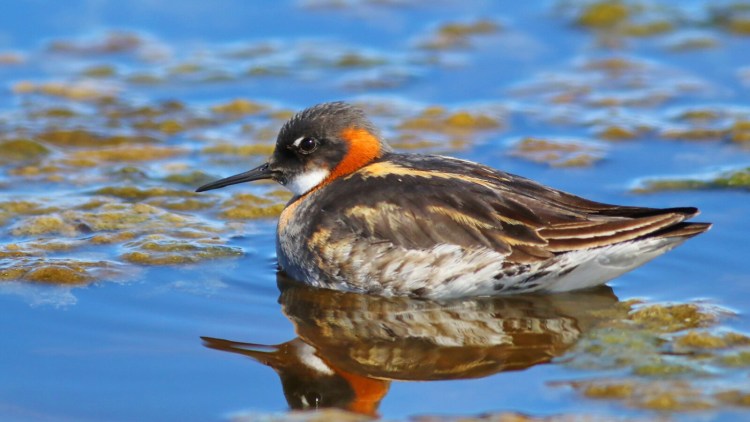My wife and I have recently returned from a week in Lubec, the easternmost town in the state of Maine. We visited one of my favorite birding spots in the state, the South Lubec Sand Bar, several times. The sand bar is a milelong spit, accessible from the South Lubec Road not far from West Quoddy Head. The sand bar is owned and maintained by the Maine Department of Inland Fisheries and Wildlife.
The bar is a regionally significant stopover site for migrating shorebirds. Thirty years ago, this habitat hosted up to 10,000 Semipalmated Sandpipers in August and September. Such spectacular numbers of this species no longer pass through the region but the species occurs regularly by the hundreds.
A birder can form an impressive list of shorebirds by hiking to the end of the bar and back. At low tide, the birds are widely dispersed along the extensive intertidal flats, a result of the 20-foot tidal range in Cobscook Bay. Birding at low tide is therefore a fool’s errand. At high tide, the birds fly inland to roost in fields and other open areas. So, to see the most birds, timing your trip to the tidal cycle is paramount.
I prefer to work the rising tide. I arrive at the bar about three hours before the predicted high tide. Within an hour, the birds are pushed near shore by the incoming tide. For the next hour, the birds are concentrated in the upper intertidal. That hour is birding heaven with the birds closely packed. As the tide pushes the birds into the upper intertidal zone where food in the mudflats is sparse, the shorebirds head for their upland roosts. Some people like to work the falling tide, arriving on site an hour or so after high tide and waiting for the shorebirds to return.

On a recent trip Downeast, Wilson spotted two marbled godwits, “the first I’ve seen in Washington County in over 30 years of birding there.” Photo by Wilfred Marissen/shutterstock
Our lists contained the usual species expected at this time of year: semipalmated plover, black-bellied plover, greater yellowlegs, lesser yellowlegs, short-billed dowitcher, semipalmated sandpiper, least sandpiper, white-rumped sandpiper, sanderling and ruddy turnstone. A couple of unseen American golden-plovers gave their distinctive, plaintive “que-del” call. Other birders found a Baird’s sandpiper and two Western sandpipers, both excellent finds for Maine. We were delighted to see two marbled godwits, the first I’ve seen in Washington County in over 30 years of birding there. We were also thrilled to see a red-necked phalarope foraging in the intertidal zone.
We found three great egrets, the first I have seen in Cobscook Bay. A female Northern harrier put on a show over the adjacent marsh. We found no falcons although peregrine falcons and merlins are often present, looking for a shorebird meal. We have even had parasitic jaegers here.
You don’t have to travel Downeast to find prime shorebird habitat. Any intertidal mudflat at this time of year will likely be productive. Just use the tide to your advantage to concentrate the birds for easy viewing. Freshwater mudflats can be productive as well, and you are not wedded to the tide table to plan a visit.
The tundra-nesting shorebirds we see show a staged migration, adults arriving first and then juveniles a few weeks later. The short breeding season in the arctic means that parents have time for only one brood per season. To increase the chances of surviving another year and reproducing again, sandpipers are under pressure to begin their southbound migration as soon as possible.
Because shorebird chicks can fend for themselves soon after hatching, the parents migrate from the breeding grounds before their young have even learned to fly! Along the Maine coast, the first adult shorebird migrants begin showing up by the middle of July. Juvenile sandpipers and plovers are just starting to arrive in Maine now.
Check your field guide to see how to distinguish adult from juveniles for each species. As a general rule, juveniles have brighter and crisper plumages, their feathers are just a few weeks old.
Herb Wilson is an Emeritus Professor of Biology at Colby College where he taught ornithology and other biology courses. He welcomes reader comments and questions at whwilson@colby.edu.
Send questions/comments to the editors.



Comments are no longer available on this story